Last Updated on 29 July 2025 by Greg Brookes
If you’re like many of my clients, you want to build strength, move better, and feel fitter, but you don’t have hours to train every day. That’s where full body kettlebell workouts come in. Back in 2006, when I first started using kettlebells, I realised how powerful they were for training the entire body efficiently. Over the years, I’ve refined these methods to help clients build real-world strength, conditioning, and resilience.
Benefits of Full Body Kettlebell Workouts
Imagine getting stronger, fitter, and more mobile, all within the same workout. That’s what full-body kettlebell training offers.
- Strength & Conditioning: Kettlebell workouts combine resistance and cardio, improving muscular strength and cardiovascular fitness simultaneously.
- Time Efficiency: You don’t need to train every muscle separately. By integrating key movement patterns, you train your entire body effectively in under 45 minutes.
- Real-World Functionality: These workouts improve coordination, balance, and movement efficiency, making everyday tasks easier.
When you understand how to combine these benefits, you unlock one of the most effective training approaches available.
How to Warm Up for Full Body Kettlebell Workouts
Before starting your session, take 5–10 minutes to prepare your body. I recommend:
- Joint Mobility: Head to toe mobilisation including shoulders, hips and thoracic spine.
- Kettlebell Prep: A few slingshots, halos and good mornings.
- Glute Activation: Bodyweight hip bridges or kettlebell deadlift patterning drills.
A good warm up will increase blood flow, activate stabiliser muscles, and prepare your nervous system for heavier lifts.
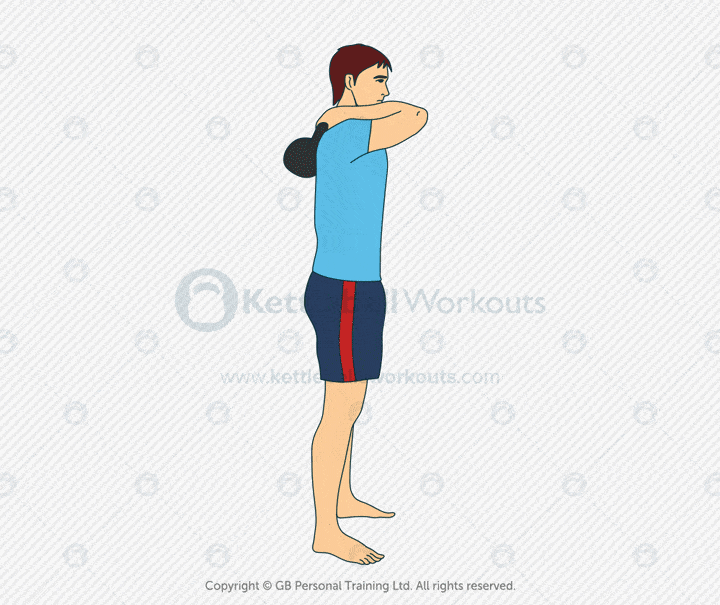
Movement Patterns for Full Body Training
To design effective full body workouts, you need to include all five essential movement patterns. Think of these as your blueprint to ensure no muscle is left behind.
1. Hinge
Targets your posterior chain, including hamstrings, glutes, and lower back.
- Exercises: Swings, cleans, deadlifts.
- Coaching Tip: Push your hips back with a neutral spine before snapping them forward to stand tall.
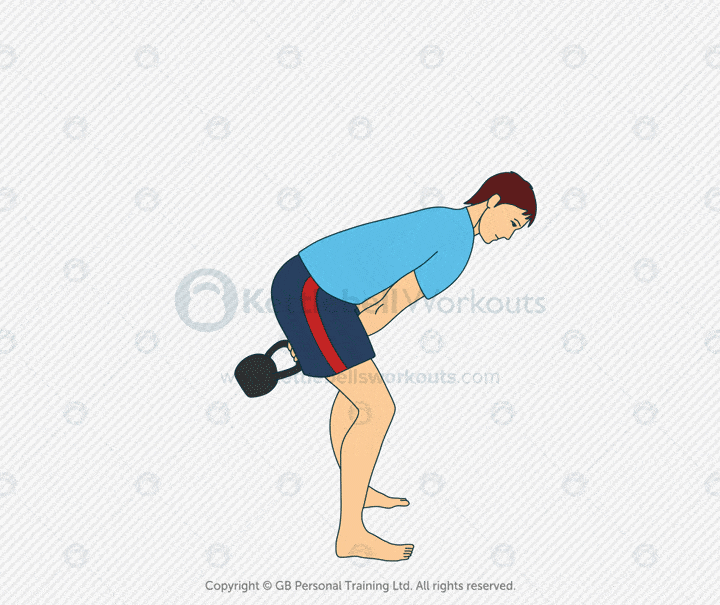
2. Knee Bend
Strengthens your quads, glutes, and improves lower body stability.
- Exercises: Goblet squats, racked squats, lunges.
- Coaching Tip: Keep your chest lifted and feet grounded as you bend your knees and drive back up.

3. Push
Builds pressing strength and shoulder stability.
- Exercises: Overhead press, push press, push ups.
- Coaching Tip: Grip the kettlebell tightly and brace your core to protect your spine as you press.

4. Pull
Develops your back, grip, and overall pulling power.
- Exercises: Single arm row, high pull, renegade row.
- Coaching Tip: Keep your shoulder down and squeeze your back muscles as you pull.
Watch a video of the renegade row in action
5. Carry or Core
Improves core strength, stability, and overall resilience.
- Exercises: Farmers carry, suitcase carry, Turkish get up, windmill.
- Coaching Tip: Move slowly and with control, focusing on maintaining full body tension.
Combining these patterns ensures every muscle is trained, creating a balanced, powerful body ready for life’s demands.
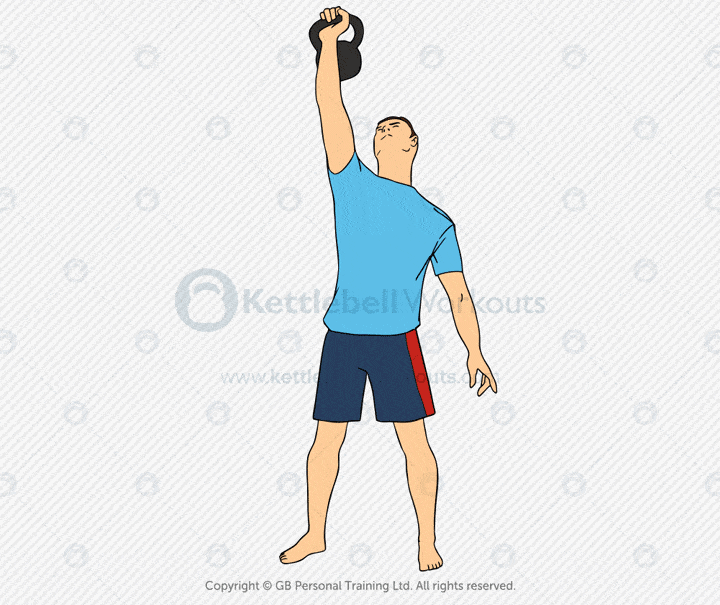
Programming Tips & Structure
Step 1: Choose Your Exercises
Pick one exercise for each movement pattern to ensure balance and full body activation.
Step 2: Match to Your Level
- Beginners: Single kettlebell exercises, 8–12 reps, full rest between exercises.
- Intermediate: Some double kettlebell exercises, using EMOM’s, AMRAPS, 6–8 reps, shorter rests.
- Advanced: Heavy doubles, flows, or explosive movements, 3–6 reps, using ladders, pyramids, or complexes.
Step 3: Structure Your Session
Start with technical or power-based movements (swings, cleans), then knee bend exercises, push, pull, and finish with carries or core drills.
Step 4: Progress Over Time
Increase load, reps, sets, or complexity each week to keep adapting and growing stronger.
Coaching Tip: Programming is like building a puzzle. Each movement pattern is a piece, together, they create a strong, balanced, and capable body.
Sample Workouts
Workout 1 – Beginner Circuit
- Two-Handed Swing x 15 reps
- Goblet Squat x 10 reps
- Overhead Press x 8-12 reps each side
- Single Arm Row x 8-12 reps each side
- Suitcase Carry x 30 seconds each side
Rest 60–90 seconds between exercises. Repeat for 2–4 rounds.
Why This Works: Builds foundational strength and movement skills safely.
Watch the Two Handed Kettlebell Swing in Action
Workout 2 – Strength & Conditioning Blend
- Double Front Squat x 6-8 reps
- Clean x 6-8 reps each side
- Push Press x 6-8 reps each side
- Reverse Lunge x 6-8 reps each side
- Turkish Get Up x 1 rep each side
Rest 90 seconds between exercises. Repeat for 4–5 rounds.
Why This Works: Combines heavy lifts with dynamic movements to build total body strength and cardio capacity.
Watch the Turkish Get Up in Action
Workout 3 – Advanced Flow
Perform as a continuous flow:
- Clean x 1 rep
- Front Squat x 1
- Press x 1 rep
- Reverse Lunge x 1 rep
Complete 3–6 rounds, before changing sides. Rest as needed.
Why This Works: Challenges coordination, stability, and full body integration.
Watch how kettlebell exercises can flow
When to Progress Your Workouts
It’s time to progress your workouts when:
- Your last reps feel smooth, easy and controlled rather than a struggle.
- You can complete all sets with perfect form and still feel you could do more.
- Workouts no longer leave you feeling challenged or energised.
Progress by increasing weight, adding reps or sets, reducing rest time, or progressing to more advanced movements.
For example, if your last goblet squat reps feel easy, switch to a racked squat or double front squat. If you can perform overhead presses for 12+ reps comfortably, progress to heavier push presses or doubles.
Always aim to challenge yourself without sacrificing form. If in doubt, increase the complexity or loading only by 10% increments each week.
How to Know Which Workout to Use Next
If you are a beginner, stick with Workout 1 until you can complete all rounds with clean form and still feel energised. Once it feels easy, move to Workout 2 for added load and complexity.
If Workout 2 starts to feel manageable, progress to Workout 3 for advanced flow and coordination demands.
How Often Should You Train and The Importance of Recovery
For most people, performing these workouts 2–3 times per week works best. Here is a simple weekly schedule to follow:
- Monday: Full body kettlebell workout
- Wednesday: Full body kettlebell workout
- Friday: Full body kettlebell workout
Use Tuesday, Thursday, Saturday, and Sunday for rest or mobility-focused sessions such as stretching, yoga, or light walking to aid recovery.
Listening to your body is key. If you feel unusually fatigued, sore, or your performance drops, take an extra rest day, focus on mobility, or reduce the load temporarily.
Training hard is important, but recovery is where your body rebuilds and adapts. Balancing effort with recovery ensures long-term progress without burnout.
This ensures you continue progressing safely and efficiently.
Why Full Body Workouts Beat Splits for Most People
Traditional split routines focus on one or two muscle groups per session. While effective for bodybuilding, they often lack efficiency for general strength, mobility, and conditioning.
Full body kettlebell workouts:
- Allow higher training frequency per pattern each week.
- Improve movement quality through regular practice.
- Build functional strength transferable to sports and daily life.
If you want to train smarter, not just harder, full body sessions are your best choice.
Kettlebell vs Dumbbell Full Body Workouts
Many ask whether kettlebells are better than dumbbells for full body workouts. Here’s my take:
Kettlebells
- Offset loading builds greater grip and shoulder stability.
- Easier transitions between exercises, ideal for flows and complexes.
- Improve coordination and control due to the centre of mass being below the handle.
Dumbbells
- Better for muscle isolation exercises due to easier balance.
- Allow greater weight variation for gradual progress.
For functional training and flows, kettlebells have the edge. For traditional hypertrophy, dumbbells are often preferable. Using both tools is optimal.
Coach’s Insight
One of my clients, a mother of two, struggled to find time for separate cardio and strength workouts. We moved to three full body kettlebell sessions per week. Within a month, her strength improved, daily energy increased, and her back pain from long hours at her desk reduced significantly.
Lesson: Full body kettlebell workouts aren’t just efficient, they build confidence and resilience in daily life.
Final Thoughts
Full body kettlebell training gives you strength, conditioning, and mobility in one session. Focus on mastering the movement patterns, progress gradually, and train with intention.
Full-body workouts are just one way to use kettlebells. Discover more goal-based training options here.
Frequently Asked Questions
Start with a weight you can press overhead for 5–8 reps with good form.
2–3 sessions per week is ideal.
Yes, especially with progressive loading and double kettlebell lifts.
Yes, they combine strength and cardio to increase calorie burn.
Circuits refer to structure (exercises in sequence). Full body workouts ensure all major patterns are trained in one session.

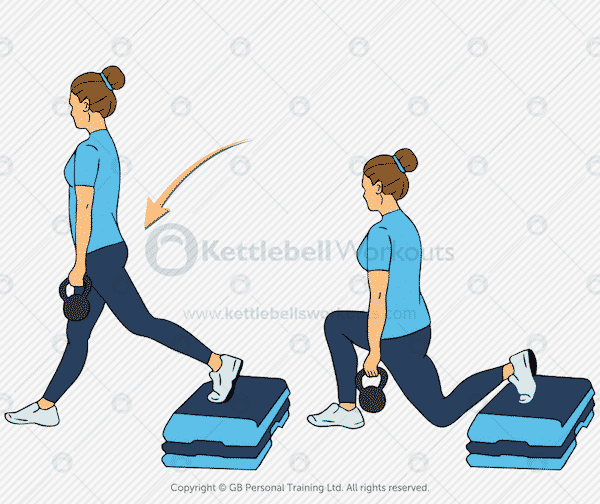
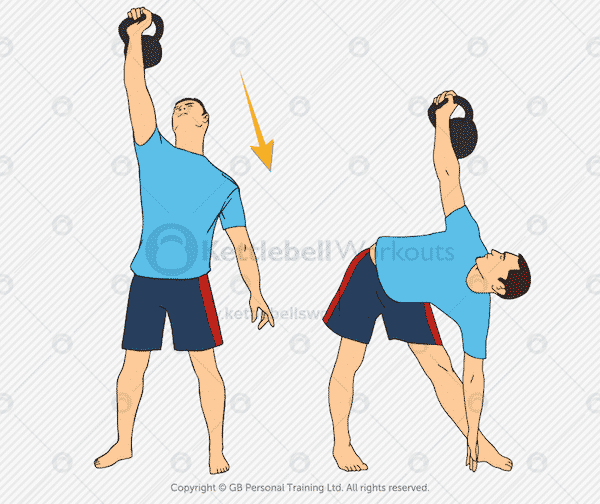

Thanks for posting these workouts. I’m getting back into things after some setbacks and this is a great way to get back into a regular routine without going overboard.
Good stuff